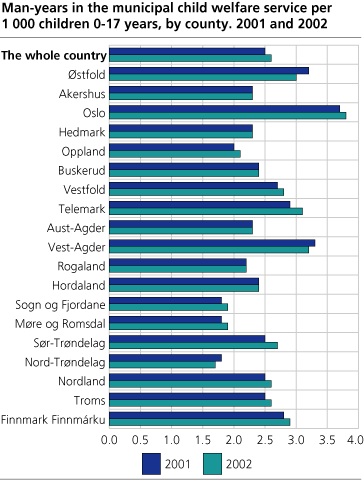Content
Published:
This is an archived release.
3 per cent more child welfare staff
A total of 2 786 man-years was registered in the municipal child welfare service in 2002. This is 83 more than the year before and an increase of 3.1 per cent. The increase from 2000 to 2001 was 117 man-years, or 4.5 per cent.
The number of staff relative to the number of children under 18 has grown from 2.5 to 2.6 man-years per 1 000 children last year. A key trend is that more and more of those employed have professional training.
Still big differences among the counties
The number of employees of child welfare services relative to the number of children under 18 years shows a national average of 2.6 man-years per 1 000 children, compared with 2.5 in 2000. The best staffing is found in Oslo, with 3.8 man-years per 1 000 children under aged 18. In second and third place are Vest-Agder and Telemark with 3.2 and 3.1 employees, respectively, for the corresponding population. Nord-Trøndelag had the lowest staffing with 1.7, and Sogn og Fjordane and Møre og Romsdal with 1.9 per 1 000 children. Oppland also had few employees in the child welfare service relative to the number of children.
The best staffing in Oslo
Among the four biggest cities, Oslo had the best staffing with 3.8 man-years per 1 000 children under aged 18. Trondheim and Bergen had in comparison 3.3 and 3.0. Stavanger had the lowest staffing with 2.8, but all of them had better staffing than the national average of 2.6 man-years relative to the number of children under 18.
More have professional training
The number of social workers and residential child care workers has increased every year since 1993. Of these two occupational groups, residential child care workers have seen the greatest increase, and they have since 1999 formed the largest professional group in child welfare service. From 1993 until today the number of residential child care workers has increased by 518 man-years or 83 per cent. In the same period the number of social workers has increased by 206 man-years, or 26 per cent. The group of employees with other college/university education has declined since 1993 by 68 man-years, or minus 20 per cent.
Residential child care workers and social workers now comprise 41 and 36 per cent, respectively, of all employees in the municipal child welfare service, and 87 per cent of all employees of the municipal child welfare service now have educations at college level. The number of unskilled workers in the municipal child welfare service has been reduced by 78 man-years since 1993, to 104 man-years in 2002, despite an increase last year of 6.7 man-years.
112 vacancies
At the end of 2002 112 positions remained unfilled in the municipal child welfare service. The number of vacancies is nearly the same as in 2001.At the end of 2002 about 4 per cent of all budgeted positions in child welfare service were vacant.
Tables:
The statistics is published with Child welfare.
Contact
-
Statistics Norway's Information Centre
E-mail: informasjon@ssb.no
tel.: (+47) 21 09 46 42

